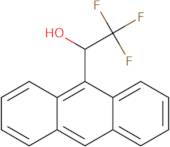Product Information
- (RS)-2,2,2-Trifluoro-1-(9-anthracenyl)ethanol
- (±)-1-(9-Anthryl)-2,2,2-trifluoroethanol
- (±)-2,2,2-Trifluoro-1-(9-anthryl)-1-ethanol
- (±)-2,2,2-Trifluoro-1-(9-anthryl)ethanol
- (±)-2,2,2-Trifluoro-1-(anthracen-9-yl)ethanol
- 1-(9-Anthracenyl)-2,2,2-trifluoro-1-ethanol
- 1-(9-Anthryl)-2,2,2-trifluoro-1-ethanol
- 1-(Anthracen-10-yl)-2,2,2-trifluoroethanol
- 1-(Anthracen-9-yl)-2,2,2-trifluoroethanol
- 2,2,2-Trifluoro-1-(9-anthracenyl)ethanol
- See more synonyms
- 9-Anthracenemethanol, α-(trifluoromethyl)-
- <span class="text-smallcaps">DL</span>-2,2,2-Trifluoro-1-(9-anthryl)ethanol
- alpha-(Trifluoromethyl)anthracene-9-methanol
- α-(Trifluoromethyl)-9-anthracenemethanol
1-(9-Anthryl)-2,2,2-Trifluoroethanol is an intermediate in the asymmetric synthesis of 1-(9-anthryl)pyrrolidin-2-one. It is synthesized from 2-fluorobenzaldehyde and 1,1,1-triacetoxybenzene by a two step process involving a nucleophilic substitution reaction followed by an elimination reaction. The compound has been shown to be a good model system for studying supramolecular chemistry due to its chiral nature and its ability to bind with other molecules through hydrogen bonding interactions. Magnetic resonance spectroscopy has shown that the molecule possesses a magnetic moment and can be used as a chiral probe for chiral recognition.





